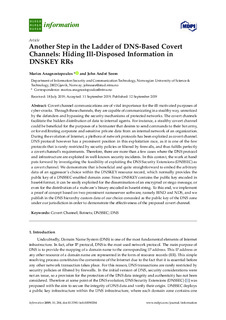| dc.contributor.author | Anagnostopoulos, Marios | |
| dc.contributor.author | Seem, John André | |
| dc.date.accessioned | 2020-02-11T07:57:47Z | |
| dc.date.available | 2020-02-11T07:57:47Z | |
| dc.date.created | 2019-10-11T09:42:50Z | |
| dc.date.issued | 2019 | |
| dc.identifier.citation | Information. 2019, 10 (9), 1-8. | nb_NO |
| dc.identifier.issn | 2078-2489 | |
| dc.identifier.uri | http://hdl.handle.net/11250/2640905 | |
| dc.description.abstract | Covert channel communications are of vital importance for the ill-motivated purposes of cyber-crooks. Through these channels, they are capable of communicating in a stealthy way, unnoticed by the defenders and bypassing the security mechanisms of protected networks. The covert channels facilitate the hidden distribution of data to internal agents. For instance, a stealthy covert channel could be beneficial for the purposes of a botmaster that desires to send commands to their bot army, or for exfiltrating corporate and sensitive private data from an internal network of an organization. During the evolution of Internet, a plethora of network protocols has been exploited as covert channel. DNS protocol however has a prominent position in this exploitation race, as it is one of the few protocols that is rarely restricted by security policies or filtered by firewalls, and thus fulfills perfectly a covert channel’s requirements. Therefore, there are more than a few cases where the DNS protocol and infrastructure are exploited in well-known security incidents. In this context, the work at hand puts forward by investigating the feasibility of exploiting the DNS Security Extensions (DNSSEC) as a covert channel. We demonstrate that is beneficial and quite straightforward to embed the arbitrary data of an aggressor’s choice within the DNSKEY resource record, which normally provides the public key of a DNSSEC-enabled domain zone. Since DNSKEY contains the public key encoded in base64 format, it can be easily exploited for the dissemination of an encrypted or stego message, or even for the distribution of a malware’s binary encoded in base64 string. To this end, we implement a proof of concept based on two prominent nameserver software, namely BIND and NDS, and we publish in the DNS hierarchy custom data of our choice concealed as the public key of the DNS zone under our jurisdiction in order to demonstrate the effectiveness of the proposed covert channel. | nb_NO |
| dc.language.iso | eng | nb_NO |
| dc.publisher | MDPI | nb_NO |
| dc.rights | Navngivelse 4.0 Internasjonal | * |
| dc.rights.uri | http://creativecommons.org/licenses/by/4.0/deed.no | * |
| dc.title | Another Step in the Ladder of DNS-Based Covert Channels: Hiding Ill-Disposed Information in DNSKEY RRs | nb_NO |
| dc.type | Journal article | nb_NO |
| dc.type | Peer reviewed | nb_NO |
| dc.description.version | publishedVersion | nb_NO |
| dc.source.pagenumber | 1-8 | nb_NO |
| dc.source.volume | 10 | nb_NO |
| dc.source.journal | Information | nb_NO |
| dc.source.issue | 9 | nb_NO |
| dc.identifier.doi | 10.3390/info10090284 | |
| dc.identifier.cristin | 1736312 | |
| dc.description.localcode | This is an open access article distributed under the Creative Commons Attribution License which permits unrestricted use, distribution, and reproduction in any medium, provided the original work is properly cited. | nb_NO |
| cristin.unitcode | 194,63,30,0 | |
| cristin.unitname | Institutt for informasjonssikkerhet og kommunikasjonsteknologi | |
| cristin.ispublished | true | |
| cristin.fulltext | original | |
| cristin.qualitycode | 1 | |

